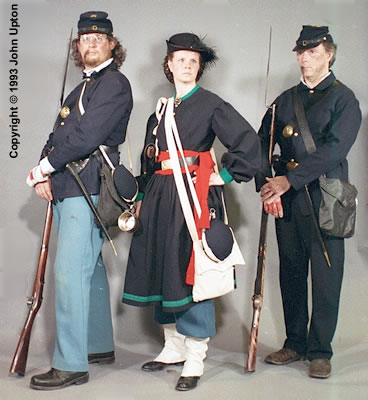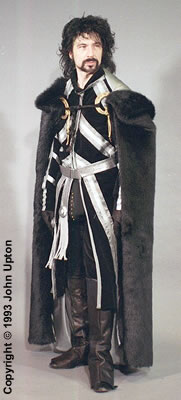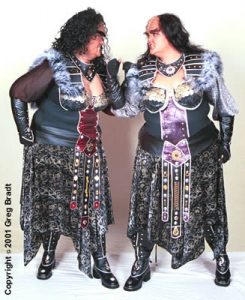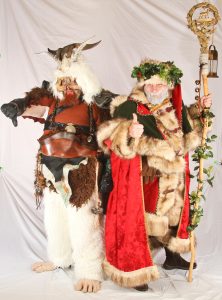CC11-H-21b: The Portrait (The Sheriff of Nottingham and Mortianna from "Robin Hood, Prince of Thieves")
CC11-H-21b: The Portrait (The Sheriff of Nottingham and Mortianna from "Robin Hood, Prince of Thieves") | Division: Master | Category: Hist. Reproduction | Designer(s): Angelique Trouvere | Maker(s): Angelique Trouvere | Presenter(s): Angelique Trouvere and John Vengrouski | Presentation Award(s): Best Media Recreation (Photo ID: John Upton 93-N12-14 | Event Date: 1993)
Competition Staff & Rules
Staff:
- Director: Pat Kennedy*
- Master of Ceremonies: Eric “Cobra” Blackburn
- Presentation Judges: Kathryn (Condon) Elms, Breighton “Rusty” Dawe, Debra Harding
Rules:
JUDGING GUIDELINES
1. THE HISTORICAL DIVISIONS
The Divisions for the Historical Masquerade Competition are different from those of the Fantasy & Science Fiction Masquerade, but serve the same purpose — i.e., they are designed to avoid forcing contestants of lesser skills and experience to compete directly against those with greater skills and experience. The framers of the Skills Division system hoped that this form of competition would play a key role in fostering increased skills, knowledge, and experience throughout the Costuming Community. This hope has, in general, been realized over the period since the system was first put into effect in international competitions.
The Divisions for the Historical Masquerade are as follows:
NOVICE: A Division designed to encourage beginners. No one may enter who is (a) a costume professional, (b) has been awarded a costume Laurel by the Society for Creative Anachronism, (c) is required to compete above the Journeyman level in any F&SF international competition, (d) has won a major award at the Journeyman level or three (3) major awards at the Novice level in historical masquerade competition, or (e) has won “Best-in-Show” in international competition.
NOTES
For the purposes of Skills Division placement, an individual who derives one-half or more of his/her annual income from activities connected with costuming will be deemed to be a costume professional. Such an individual will be considered an historic costume professional if the majority of such activities are connected with reproductions/recreations of historical costumes.
For the purposes of Skills Division placement, a major award is one which includes the terminology “Best [any title]”, “Most [any title]”, or”Honored for Excellence”. “Honorable Mention” awards do not count as major awards. Workmanship awards are not used in determining Division placement.
JOURNEYMAN: An intermediate division to allow further development of costuming skills. No one may enter who (a) is an historic costume professional, (b) has been awarded a cosine Laurel by the Society for Creative Anachronism, (c) has won a major award at the Master level or three (3) major awards at the Journeyman level in historical masquerade competition, or (d) has won “Best-in-Show” in international competition.
MASTER: A completely open Division — anyone may enter.
2. THE HISTORICAL CATEGORIES
In addition to the Skill Divisions, which apply to entrants, the Historical Masquerade Competition will also be divided into Reproduction and Interpretation Categories, which apply to the costumes themselves. Costumes from both categories are eligible for “Best-in-Show”, but otherwise the categories will not compete against each other. These categories are defined as follows:
HISTORICAL REPRODUCTION (Also variously known as Historical Re-creation and Historical Dress): A garment which is carefully researched, documented, patterned, cut, assembled, finished, and presented in a manner appropriate to the period from which it is drawn. Authenticity and accuracy to the source are the key elements, although the garment need not be a reproduction of any single particular garment. Completeness of documentation is also crucial in this Category, because the costume wi11 be judged primarily against its documentation.
NOTES
Costumes intended to be accurate “from the skin out” will normally be entered in this Category.
Costumes which are re-creations of movie costumes will likewise normally be entered in this Category even though the movie costume in question might itself be an “interpretation” of an historic garment.
HISTORICAL INTERPRETATION (Also known as Historic Costume): A garment which reflects and deliberately re-works major design elements from one or more historical periods. A garment which is an imaginative “spin-off”, based upon one or more historic garments or upon an historic premise. Examples from the past include a Wild West scenario, Art Nouveau posters, Marie Antoinette as “A Motorcycle Slut” and “A Musketeer From Mars”. The stronger the historic basis, the better the interpretation, bur creativity is the key element in this Category; “authenticity” is secondary.
3. JUDGING CRITERIA
In contrast to the F & SF Masquerade, the Historical Masquerade Competition is judged on a “points” basis, where points are awarded and tabulated in the following areas:
DOCUMENTATION: Of crucial importance for Historical Reproductions. in which costumes will be judged primarily against the documentation, but also a major factor in imaginative Historical Interpretations. Judges for the Historical Masquerade agree to read all documentation for all entries before the masquerade, and to have it available for reference during both pre-judging and all deliberations. Documentation itself will be judged as part of the costume, with points awarded as follows:
0 – No documentation, or obviously inaccurate. [Questions of accuracy can be raised during pre-judging, and costumers will be given every opportunity to prove accuracy when and if there is any doubt.]
1 – Minimum information listing period, geographic location, and pattern source.
2 – Same as for 1 point with photographs/photocopies of drawings, but with no additional detail
3 – Same as for 1 point with additional detail including, as a minimum, specific examples, primary sources if available, and rationale for fabric, color, and design of the major elements of garment and construction.
4 – Same as for 3 points plus rationale for all elements of the costume including the minor details; a display of understanding of the period represented; explanation of any deviations from the period norm.
AUTHENTICITY: This will be judged to the degree the entrant wishes. Reproductions of clothing striving for accuracy will be carefully examined in a pre-judging session
recognition. (sic) [On a corollary note, Historical Interpretation costumes need not be judged “from the skin out”:] Points for authenticity will be awarded as follows:
0 – Blatantly modem.
1 – Period elements incorrectly combined (i.e., inappropriate mix of time and culture) [not applicable to re-creations of movie costumes]
2 – Superficially authentic, but with unauthentic elements of design, color, fabric, etc. (“Theater costume”, faked underpinnings, et. al.) [not necessarily applicable to re-creations of movie costumes]
3 – Authentic in look and feel. Attempt made to reproduce the “hand” of original fabrics and to imitate period techniques.
4 – Same as for 3 points plus a special effort to achieve total period effect. Embellishment and/or accessories made by the entrant; presented with movement and manner correct for the period.
CREATIVITY (Historical Reproduction): A different type than that for the F&SF costumer comes into play in the Historical Masquerade. Rather than relying on a purely original premise, historical “creativity” points will be awarded as follows:
0 – An exact copy from a modem source such as Folkwear Patterns.
1 – A standard style for the period, mostly copied from a familiar source such as The Evolution of Fashion.
2 – Logical combination of period elements, taken from various sources.
3 – Individual interpretation, logical to the period.
4 – Innovative combination of elements, logical to a single period, looking as if it were the work of a single creative historical designer (perhaps a known designer).
WORKMANSHIP: Quality is quality no matter what the category, and a beautiful job deserves recognition. The elements of workmanship that the judges will be rating are:
Technical: Seam finishing, stitching, neatness
Fit: Does it hang correctly? Is the move and fit appropriate to the period and style?
Handling of Fabric: Appropriateness of fabric; handling of nap, print, bias, etc.
Construction Details: Interfacing, smocking, pleating, applique, embroidery, linings
COMPLEXITY: This applies to the scope of the project attempted rather than to the workmanship. The elements of complexity will be:
Scope of the Project: Number of pieces: size in relationship to detail, etc.
Variety of Techniques Used: (as appropriate to the costume)
Difficulty of the Techniques Attempted
Extent of Original Pattern Work: (done by the entrant)
OVERALL OBSERVATION: How well do the separate elements work together?
BONUS POINTS: After the judges have scored the contestants in the above areas, bonus points may be awarded for such things as hand sewing, truly authentic fabrics, etc. Bonus points will not “save” a mediocre costume, but they may serve as a “tie breaker” between two outstanding ones.




